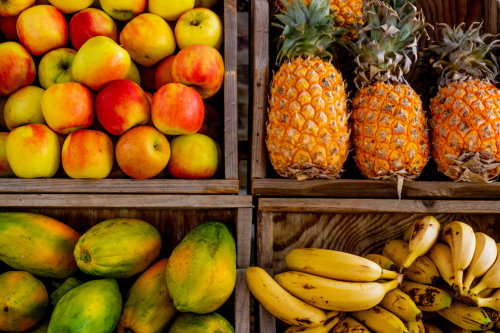"A balanced diet" isn't quite as simple as the four food groups anymore, but nutrition experts list the supplements that can help you get all the nutrients you need.
Nearly one-third of the US population was at risk of deficiency in at least one vitamin or mineral, according to 2017 research published in Nutrients. The Oregon State University Linus Pauling Institute (OSULPI) suggests nutrient insufficiencies are even more widespread—and maintaining less-than-optimal levels of some nutrients can have serious health consequences.
BREAKING: Shed 42 lbs In 30 Days With This Simple Night-time Pill
A vitamin or mineral insufficiency is defined as inadequate stores of a nutrient, meaning they’re not at the optimal levels for your body. Sara Riehm, RD, LD/N, CSOWM, a registered dietitian with Orlando Health Center for Health Improvement, says, “A deficiency would be a more severe type of insufficiency, where the nutrients may be present only in very small amounts or completely absent.”
This nutrition expert adds that nutrient deficiencies often lead to health complications with obvious signs and symptoms, whereas symptoms of inadequate intake may only be recognizable with clinical testing.
Vitamins and minerals American aren’t getting enough of
Experts recommend increasing these vitamins and minerals through foods in your diet, if possible. Nutrients from food “are more bioavailable and can increase levels faster,” explains Amber Core, RD, a registered dietitian at The Ohio State University Wexner Medical Center.
But if for any reason you struggle to get enough of a certain nutrient, even doctors take supplements themselves—just speak with your healthcare provider first to ensure it’s necessary and that you’re taking the correct dosage.
1. Vitamin D
“Vitamin D is one nutrient that most people in the United States are deficient in, specifically those living in large cities or central and Midwestern states that do not get good sun exposure year-round,” Core says. The OSULPI says around 95% of US adults don’t get enough vitamin D.
“Some early signs of vitamin D deficiency can include fatigue, poor mood, difficulty sleeping and muscle weakness,” Core says. Over time, low vitamin D can contribute to rickets in children or osteoporosis in adults…or possibly lower immunity for both.
“Vitamin D is mostly synthesized on our skin with exposure to sunlight; however, salmon and sardines contain it as well,” says Stephanie Roit, RD, a registered dietitian at NewYork-Presbyterian/Weill Cornell Medical Center. It’s also available in fortified foods such as orange juice, ready-to-eat cereals, or mushrooms exposed to UV light, Riehm adds. (Eggs are a good source, too!)
2. Calcium
More than 44% of the US population doesn’t get the recommended amount of calcium in their diet, according to the OSULPI. Calcium insufficiency can lead to muscle cramps, brittle nails, or dry skin, Riehm says, adding: “As insufficiency worsens, we could start to see neurological effects like confusion, memory problems or hallucinations.”
A severe calcium deficiency can lead to bone and muscle problems, seizures, abnormal heart rhythms and congestive heart failure. That said, low calcium is not always symptomatic.
Dairy is the most common and readily available food source of dietary calcium, but plant-based foods such as tofu, leafy greens and broccoli are great sources as well, Riehm says.
3. Potassium
“Potassium is one of the main electrolytes in the body, but many of us do not get enough each day,” Core says. “We need about 3,400 milligrams (mg) per day from foods such as potatoes, bananas, raisins and yogurt.”
Even mild potassium insufficiency can lead to constipation, muscle weakness or spasms, tingling and numbness, extreme fatigue or possibly heart palpitations, Riehm says. According to the National Institutes of Health, a low potassium intake can also increase your risk of high blood pressure and stroke, kidney stones and type 2 diabetes.
4. Iron
“Iron deficiency is quite common in the United States,” Core says. “While it can lead to microcytic anemia, it can also include other symptoms such as fatigue, pale skin, brittle nails and an increased heart rate.”
The amount of iron a person needs varies based on age and gender. Women aged 14 to 50 years require more than men (and even more when pregnant), and they’re also at a greater risk of deficiency. A 2023 report in the Journal of the American Medical Association found that 39% of American females ages 12 to 21 years have an iron deficiency.
“There are two main forms of iron present in our foods—heme and non-heme,” Riehm explains. If you’re looking to increase iron levels quickly, heme iron (found in meat, poultry or fish) is more readily absorbed by the human body. Plant-based foods such as white beans, lentils and spinach contain non-heme iron.
5. Magnesium
An estimated half of Americans don’t get enough magnesium, according to the National Institutes of Health. This mineral is responsible for helping maintain healthy blood pressure and forming new bone, protein, and DNA in the body. It’s also necessary for our bodies to effectively use vitamin D, per a 2018 review published in the Journal of Osteopathic Medicine.
TRENDING: Doctors Can't Believe She Used This To Erase Her Wrinkles...
“Some signs that you aren’t getting enough magnesium include poor appetite, muscle weakness or spasms, and heart arrhythmias,” Core says. “The best food sources of magnesium are nuts and seeds, dark chocolate and dark leafy greens.”
6. Vitamin C
Almost 40% of us aren’t getting the recommended amount of vitamin C, according to the OSULPI. “Symptomatic vitamin C deficiency is rare,” Roit explains—but could include fatigue, depression, and easy bruising. “Vitamin C can be found in fruits and vegetables, especially citrus fruits, kiwi, strawberries, red peppers, broccoli and potatoes,” she says.
7. Vitamin A
The OSULPI says that 43% of Americans have suboptimal vitamin A levels. “Vitamin A is a nutrient commonly found in orange foods, such as sweet potatoes, pumpkin and salmon,” Core says. “Without eating these foods, deficiency can occur, and may include symptoms such as difficulty seeing in low-light, frequent infections and dry skin.” Vitamin A also helps amp up your immune system—read up on the fall soup recipe one doctor’s making to stay healthy this year.









